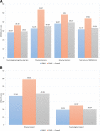Economic burden of multiple sclerosis in a population with low physical disability
- PMID: 31109317
- PMCID: PMC6528334
- DOI: 10.1186/s12889-019-6907-x
Economic burden of multiple sclerosis in a population with low physical disability
Erratum in
-
Correction to: Economic burden of multiple sclerosis in a population with low physical disability.BMC Public Health. 2019 Jul 8;19(1):909. doi: 10.1186/s12889-019-7275-2. BMC Public Health. 2019. PMID: 31286946 Free PMC article.
Abstract
Background: In multiple sclerosis (MS), half of affected people are unemployed within 10 years of diagnosis. The aim of this study was to assess the economic impact of MS in adult subjects with relapsing-remitting MS (RRMS) and primary progressive MS (PPMS).
Methods: A multicenter, non-interventional, cross-sectional study was conducted. The Expanded Disability Status Scale (EDSS) and the 23-item Multiple Sclerosis Work Difficulties Questionnaire (MSWDQ-23) were used to assess disability and work performance, respectively. Only indirect costs were considered using the human capital method, including work costs. Professional support costs and informal caregivers' costs were also estimated.
Results: A total of 199 subjects were studied (mean age: 43.9 ± 10.5 years, 60.8% female, 86.4% with RRMS). Median EDSS score was 2.0 (interquartile range: 1.0-3.5) and median MSWDQ-23 total score was 31.5 (15.2, 50.0). The number of employed subjects decreased after MS diagnosis from 70.6 to 47.2%, and the number of retired people increased (23.6%). Mean age of retirement was 43.6 ± 10.5 years. Ten percent of the population had sick leaves (absenteeism was seen in 90.9% of the student population and 30.9% of the employed population). Professional support in their daily life activities was needed in 28.1% of subjects. Costs for sick leave, work absenteeism, premature retirement and premature work disability/pensioner were €416.6 ± 2030.2, €763.4 ± 3161.8, €5810.1 ± 13,159.0 and €1816.8 ± 9630.7, respectively. Costs for professional support and informal caregiving activities were €1026.93 ± 4622.0 and €1328.72, respectively.
Conclusions: MS is responsible for a substantial economic burden due to indirect and informal care costs, even in a population with low physical disability.
Keywords: Burden of illness; Caregiver; Costs; Disability; Multiple sclerosis.
Conflict of interest statement
JM, NM, and ER-B are employees of Roche Farma Spain. None of the other authors report any conflict of interest.
Figures
References
-
- Chen J, Taylor BV, Palmer AJ, et al. Estimating MS-related work productivity loss and factors associated with work productivity loss in a representative Australian sample of people with multiple sclerosis. Mult Scler. 2018:1352458518781971. 10.1177/1352458518781971 [Epub ahead of print]. - PubMed
MeSH terms
Grants and funding
LinkOut - more resources
Full Text Sources
Medical



